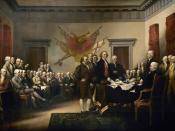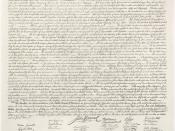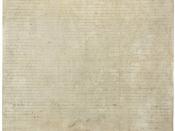An exhibit displayed at the Library of Congress is titled, Declaring Independence: Drafting the Documents. This exhibit is unique because it will eventually end up in the permanent exhibition called "Treasure of the Library of Congress" which will open in 1997. Such a document is considered a treasure to the Library of Congress because of its association with Thomas Jefferson and because of what it symbolizes. This founding document stands for the dozens of men that got together in the middle of a political crisis and finally agreed upon a handwritten draft that was written and rewritten again. The exhibit of this "treasure" covers the (1) Chronology of Events, (2) The Drafting of the Documents, and (3) The Objects in the Exhibition.
The events that led up to the Declaration of Independence began on June 7, 1776, with Richard Henry Lee's resolution urging Congress to declare independence and ended on January 18, 1777 with Congress ordering that signed copies of the Declaration of Independence printed by Mary Katherine Goddard of Baltimore be sent to the states.
In the seven months preceding the production of the final copy of the Declaration of Independence, the following events took place: Jefferson drafted the declaration; a copy of the draft was read in Congress; Congress debated and revised the Declaration of Independence; Congress then declared independence and adopted the Declaration of Independence on July 4, which are now termed "Dunlap Broadsides". These prints were dispatched to the legislatures of New Jersey and Delaware. The first newspaper rendition of the Declaration of Independence was printed in a local Pennsylvania newspaper and was read for the first time in public in Philadelphia. Consequently, it was read before the American army in New York. The Declaration of Independence was signed by members and later by delegates.


